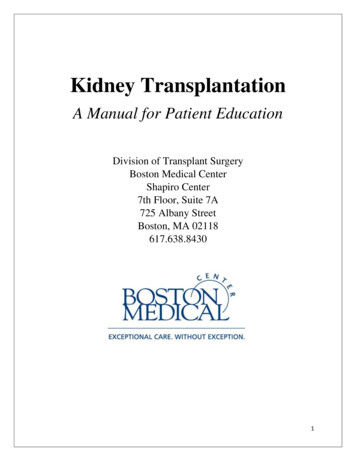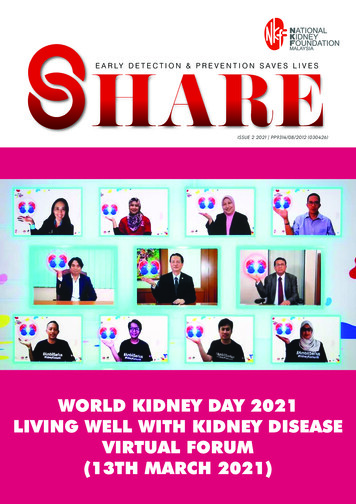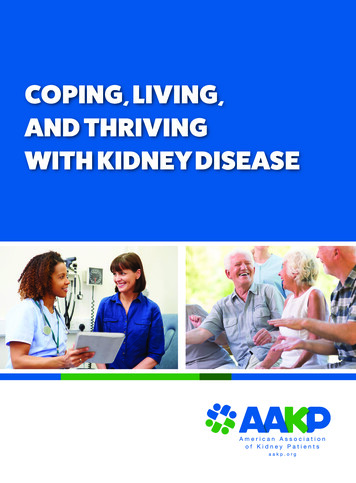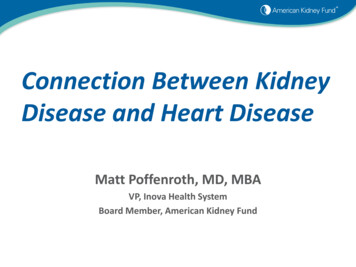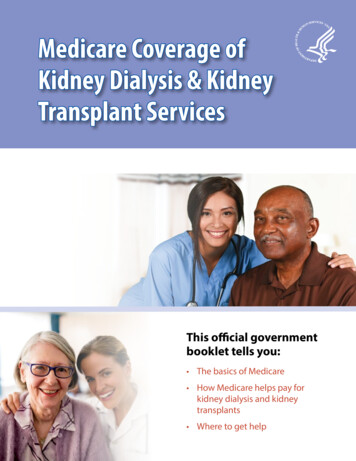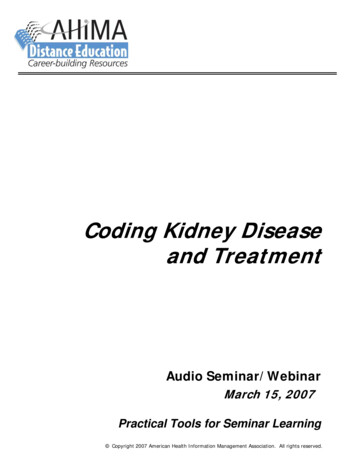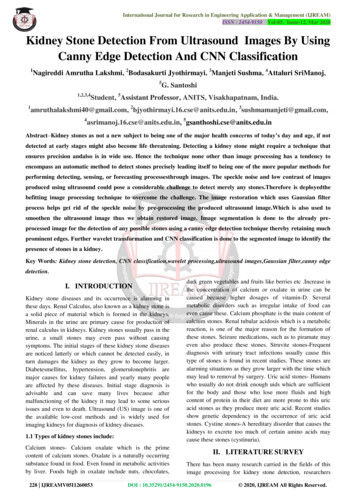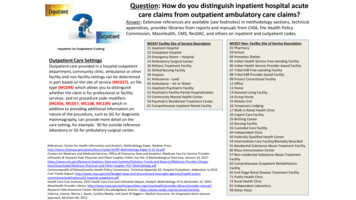
Transcription
Wang et al. Systematic Reviews(2019) OCOLOpen AccessOutpatient kidney recovery after acutekidney injury requiring dialysis: asystematic review protocolCarol Wang1, Swapnil Hiremath2, Lindsey Sikora3, Manish M. Sood2, Jennifer Kong4 and Edward Clark2*AbstractBackground: Acute kidney injury requiring dialysis (AKI-D) during hospitalization is associated with both in-hospitaland post-discharge mortality. Its incidence has risen over time in Canada and the USA. While the majority of AKI-Dwill recover to dialysis independence at the time of hospital discharge, 10–30% will transition to outpatient dialysis.The risk factors that determine dialysis independence after AKI-D and its optimal outpatient management remainunclear. Eliciting prognostic predictors of kidney recovery in patients who remain on dialysis after hospital dischargewill guide subsequent clinical decision making. The objective of this study is to assess the association betweenpatient- and treatment-related factors with short- and long-term outcomes in patients who remained dialysisdependent after hospitalization with AKI-D.Methods: A literature search in EMBASE, MEDLINE, and PubMed will be performed based on pre-specified criteria.There are no restrictions on language and publication dates. The supplemental search will include manual scan ofbibliographies of eligible studies and grey literature assessment. Pre-specified criteria will be used to select eligiblestudies. Relevant data will be extracted and quality assessments performed per validated tools. Qualitative datasynthesis will be performed to reflect directions of associations. Meta-analysis will be formed if two or more studieswith similar prognostic factors, outcomes, and adequate quality are identified. Strength of association will bequantified as odds ratios. Reporting of this review will be guided by recommendations of the Preferred ReportingItems for Systematic Reviews and Meta-Analyses (PRISMA) statement.Discussion: This systematic review aims to synthesize association between modifiable and non-modifiableprognostic factors with renal outcomes in AKI-D patients who remain dialysis-dependent after hospital discharge.Our findings will help inform the development of evidence-based management and guide long-term treatmentplanning for AKI-D patients.Systematic review registration: PROSPERO registration number CRD42019127394.Keywords: Acute kidney injury, Dialysis, Prognostic factors, Kidney recovery, Systematic reviewBackgroundAcute kidney injury requiring dialysis (AKI-D) occurs in1–2% of hospitalized patients [1, 2]. In the USA, the incidence of AKI-D has increased in the span of 2000–2014,especially in patients with diabetes [3]. A retrospectivepopulation-based study in Ontario, Canada, demonstrateda fourfold increase in AKI-D from 0.8 to 3% between 1996* Correspondence: edclark@toh.ca2Division of Nephrology, Department of Medicine, The Ottawa Hospital andUniversity of Ottawa, The Ottawa Hospital – Riverside Campus, 1967Riverside Drive, Ottawa, Ontario K1H 7 W9, CanadaFull list of author information is available at the end of the articleand 2010 [4]. AKI-D is also associated with increased riskof both in-hospital and post-discharge mortality [1, 5].Approximately 10–30% of patients with AKI-D who survive to hospital discharge will require outpatient dialysis[6]. Furthermore, 1 in 12 of those patients with kidney recovery to dialysis independence at the time of dischargewill eventually need to resume it within 3 to 5 years’ time[1]. The factors that determine the extent of kidney recovery after AKI-D remain unclear and are likely to consist ofa range of modifiable and non-modifiable factors [2]. The Author(s). 2019 Open Access This article is distributed under the terms of the Creative Commons Attribution 4.0International License (http://creativecommons.org/licenses/by/4.0/), which permits unrestricted use, distribution, andreproduction in any medium, provided you give appropriate credit to the original author(s) and the source, provide a link tothe Creative Commons license, and indicate if changes were made. The Creative Commons Public Domain Dedication o/1.0/) applies to the data made available in this article, unless otherwise stated.
Wang et al. Systematic Reviews(2019) 8:214An improved understanding of predictors of kidneyrecovery to dialysis independence in outpatients who require ongoing dialysis after a hospital encounter withAKI-D (as well as the gaps in knowledge in this area) canimprove patient-centered decision-making and clarify theneed for further research in this area. For patients unlikelyto have kidney recovery, earlier and better-informed decision-making regarding long-term arteriovenous access,home therapies, and transplantation would be facilitated.This could improve patients’ quality of care; improve access, integration, and utilization of chronic kidney diseasesystem resources; and improve access to transplant andhome dialysis. For caregivers of patients more likely to recover, frequent assessment for recovery and strategies tolimit further kidney damage (e.g., avoidance of intradialytic hypotension and nephrotoxins) may facilitate shorterrecovery times and increase the likelihood of recovery todialysis independence. Lastly, a better understanding ofthe risks of death and dialysis dependence would help patients navigate their options regarding palliative/conservative care after having gained some experience as to what isinvolved in undergoing maintenance dialysis in the outpatient setting.The optimal outpatient management of AKI-D patientsremains uncertain. Currently, no evidence based-guidelinesexist for the best management of AKI-D patients in orderto optimize kidney recovery [1, 2]. Many observationalstudies have reported on predictors of kidney recovery priorto hospital discharge [2, 5–7]. Nonetheless, some patientswho require ongoing outpatient dialysis after hospital discharge will go on to recover kidney function to dialysis independence. Much less is known about risk factors thatinfluence kidney recovery in the outpatient setting after ahospital encounter with AKI-D. Here, we present a protocol for a systematic review that will seek to assess the association between both patient- and treatment-related factors(modifiable and non-modifiable) with short- and long-termoutcomes in patients who remained dialysis-dependentafter a hospitalization with AKI-D.Page 2 of 5recovery in AKI-D patients who remain dialysisdependent after hospital discharge. Only original peerreviewed literature will be included. Studies published inall languages will be included. In addition, the followingcriteria must also be met:Patient populations: Patients 18 years or older withacute kidney injury treated with dialysis of any type during a hospitalization who transition to outpatient dialysisafter hospital discharge. Those with pre-existing endstage renal disease defined as estimated glomerular filtration rate (eGFR) 15 ml per minute per 1.73 m2 priorto hospitalization will be excluded.Variables of interest or predictive factors: Anyindependent variable examined for potential prognosticability will be included. We will begin with a broad studyapproach that spans a variety of prognostic factors whichwill subsequently be grouped into relevant domains.Potential domains include demographics (e.g., gender, age,ethnicity, pre-existing comorbidities), hospitalization-related factors (such as etiology of acute kidney injury,volume status at initiation of renal replacement therapy(RRT), ward versus intensive care unit admission, durationof hospitalization, urinary output at the time of hospitaldischarge), and treatment-related factors including modality of RRT initiated in hospital and characteristics of RRTafter discharge.OutcomesMethodsThe primary outcome of interest in this systematic review is kidney recovery to dialysis independence within90 days after hospital discharge. This time interval isregarded as the threshold at which most patients wouldbe considered to have reached end-stage renal disease[1]. The secondary outcomes of this study include kidney recovery to dialysis independence at any time pointafter hospital discharge, death at any time point afterhospital discharge, progression to end-stage renal disease, and long-term RRT dependence, kidney transplantation, serum creatinine, and/or estimated glomerularfiltration rate amongst those that recover to dialysisindependence.Eligibility criteriaTypes of studiesSearch strategyAll studies that have reported on predictors of kidney recovery and clinically relevant outcomes (listed below) inAKI-D patients requiring post-hospitalization dialysis areeligible. These studies must present predictive/prognosticfactors from baseline to follow-up period. In addition,studies must be full-text, peer-reviewed articles. This review will include both observational and interventionalstudies. Case reports or case series of less than or equal to10 patients will be excluded. No restrictions will be placedon the study duration, study period, or date of publication.Studies must have analyzed potential predictors of kidneyNo prior published studies that addressed similar topicswere found in PubMed, MEDLINE (via Ovid), andEMBASE (via Ovid). Similar systematic review study protocols have not been registered on PROSPERO. A healthsciences librarian (LS) searched the following databases:MEDLINE and MEDLINE in Process (via OVID), EmbaseClassic Embase (via OVID), Cochrane’s Central Registryfor Randomized Controlled Trials, CENTRAL (via OVID),and PubMed. Appendix 1 demonstrates our search strategy, which was initially developed in MEDLINE thentranslated into other databases. All databases will be
Wang et al. Systematic Reviews(2019) 8:214searched from the date of inception to April 1, 2019. Nolanguage exclusion criteria nor other publication restrictions were incorporated into the search strategy. All references will then be entered into EndNote (version X9,Clarivate Analytics Inc., Philadelphia, PA) citation manager for processing. Supplemental search will consist ofmanual scanning of bibliographies in eligible studies, greyliterature search of clinical trial registries such as clinicaltrials.gov, and screening for relevant titles in the first threepages of the Google Scholar search. Relevant articles willbe screened at two levels: title/abstract then full-textscreening, by two reviewers (CW and EC) in the systematic review software, Covidence (Veritas HealthInnovation LTD).Study recordsData managementRelevant data will be extracted from Covidence (VeritasHealth Innovation LTD) and managed with MicrosoftExcel. Data will be synthesized with the ComprehensiveMeta-Analysis (version 2, Biostat) software.Data collection processTwo investigators (CW and EC) will independently screenrelevant study titles and abstracts per pre-specified criteriato determine their eligibilities for full-text assessment. Thesame investigators will subsequently examine the full textsof the selected studies according to the inclusion and exclusion criteria. Relevant studies published in English orFrench will be included. Disagreements will be resolvedwith discussion until consensus is reached. A PRISMAdiagram will be generated to document the study selectionprocess [8].Page 3 of 5transition to long-term RRT, eGFR at the time ofkidney recovery, time from hospital discharge tokidney recovery, and kidney transplantation.4. Study characteristics: author, publication year,number of study participants, type of study(research design), and duration of follow-up.Quality assessmentThe qualities of reporting and risk for bias of each includedstudy will be appraised using validated tools. Prognosticstudies that meet the inclusion criteria will be assessed forinternal validity with the Quality In Prognostic Studies(QUIPS) tool [9]. The quality of reporting of observationalstudies will be assessed in accordance with Strengtheningthe Reporting of Observational Studies in Epidemiology(STROBE) checklist [10, 11]. The Cochrane Risk of Bias Assessment Tool for Non-Randomized Studies of Interventions (ROBINS-I) will be utilized to evaluate observationalstudies that assessed interventions [12]. The strength of theemerging evidence will be evaluated using the Grading ofRecommendations Assessment, Development, and Evaluation (GRADE) method [13]. These assessments will be performed by two investigators (CW and EC) independently,and disagreements will be resolved by consensus or involvement of a third reviewer (SH) if required.Data synthesisQualitative/narrative synthesisA narrative synthesis will be performed to reflect directions of associations between prognostic factors and outcomes of interest. These associations will be reported aspositive, negative, or none for each domain of risk factors.Quantitative synthesisData extractionA data extraction form will be created and populatedwith the following information:1. Patient demographics: age, gender, ethnicity.2. Investigated independent variables/predictors: Patient comorbidities: baseline creatinine (ifavailable), pre-existing chronic kidney disease,diabetes, congestive heart failure, etc. Hospitalization-related factors: etiology of acutekidney injury, volume status at initiation of RRT,ward versus intensive care unit admission,duration of hospitalization, urine output at thetime of hospital discharge. Treatment-related factors: modality of RRTinitiated in hospital, characteristics of outpatientRRT after discharge.3. Outcomes: kidney recovery after hospital discharge,mortality at any time point after hospital discharge,progression to end-stage renal disease withMeta-analyses will be performed if the data is appropriate for quantitative synthesis. Minimum of twostudies is required to provide data of the same prognostic factors pertaining to outcomes of interest topermit data pooling and synthesis. The strength of association between identified prognostic factors andoutcomes will be quantified as odds ratios for eachoutcome of interest. Cochran’s Q and the I2 test willbe used to examine the statistical heterogeneity between studies [13]. Publication bias will be assessedby visual examination of the funnel plot and usingthe Egger test [14]. Statistical analyses will be conducted using the generic inverse variance method inReview Manager software (RevMan, version 3).Protocol amendmentsAny amendments to the protocol will be outlined inan addendum made to specify and justify changes.These modifications and their justifications will alsobe included in the final report.
Wang et al. Systematic Reviews(2019) 8:214DiscussionAKI-D during hospitalization is a frequent occurrence andis associated with poor outcomes. To date, there is a paucity of data on the epidemiology and outcomes of patientswith AKI-D who remain dialysis-dependent at hospitaldischarge. Our proposed systematic review will synthesizewhat is known about the association of patient and treatment-related factors with short- and long-term outcomesin this population. We hope to shed light on modifiableprognostic factors that influence renal outcomes. The results could help inform the development of evidencebased clinical decision-making both during and afterhospitalization of AKI-D patients in addition to guide patient counseling and navigate long-term care planning.Appendix 1Ovid Technologies, Inc. Email Service Search for: 39 and52 and 66Results: 147Database: Ovid MEDLINE(R) and Epub Ahead ofPrint, In-Process & Other Non-Indexed Citations andDaily 1946 to October 09, 2018 Search Strategy:1 exp Acute Kidney Injury/ (41734)2 (acute adj (kidney or renal or nephr* or tubular ordialys*)).ti. (23152)3 (acute adj2 (kidney or renal)).tw. (45381)4 ((crescent* or progressive or anca* or acute) and(glomerul* or nephrit*)).ti. (5627)5 ((kidney or renal) adj isch?emi*).ti. (2199)6 *Nephritis, Interstitial/ci [Chemically Induced] (942)7 *Hemorrhagic Fever with Renal Syndrome/ (2316)8 (induced adj (kidney injury or renal injury)).tw.(1469)9 Oliguria/ (1261)10 acute nephr*.tw. (1079)11 (pre-renal or prerenal).tw. (1032)12 ((arf or aki) and (renal or kidney)).tw. (12162)13 ((nephropath* and (contrast* adj (medi* or inducedor agent*))) or radiocontrast* or iodinated or crystal*or cast).mp. (463879)14 (nephrotox* or (renal and toxi*)).ti. (9125)15 renal tubul*.ti. (6387)16 14 or 15 (15370)17 ci.fs. or contrast medi*.tw. or induced.mp. (2571306)18 16 and 17 (8116)19 ((kidney or renal) adj isch?emi*).tw. (4807)20 Kidney Tubules, Proximal/ (12488)21 ur?emi*.ti. (14507)22 renal inflammation.tw. (1127)23 19 or 20 or 21 or 22 (32601)24 *Reperfusion Injury/ (19063)25 isch?emi* reperfusion.tw. or injury.ti. or acute.tw.(1248297)26 24 or 25 (1250950)27 23 and 26 (7078)Page 4 of 528 h?emolytic ur?emi*.ti. (3812)29 (thrombotic adj (thrombocytopeni* or microangiopathy)).tw. (6588)30 28 or 29 (9770)31 (kidney or renal or acute).mp. (2048405)32 30 and 31 (4803)33 (induced adj (kidney or renal)).tw. (6968)34 (nephrotox* or contrast medi* or reperfusion orperfusion).mp. (361366)35 33 and 34 (2354)36 ((tubulointerstitial or interstitial or anti-glomerularor antiglomerular) and (glomerul* or nephrit*)).ti.(3139)37 (acute or crescentic or atypical or progressive).mp.(1509375)38 36 and 37 (1537)39 1 or 2 or 3 or 4 or 5 or 6 or 7 or 8 or 9 or 10 or 11or 12 or 13 or 18 or 27 or 32 or 35 or 38 (547523)40 exp Renal Replacement Therapy/ (192706)41 ((kidney* or renal) adj3 replacement adj2 therap*).tw.(11268)42 exp Renal Dialysis/ (107143)43 ((renal or extracorporeal) adj2 dialys#s).tw. (2899)44 exp Hemofiltration/ (6454)45 h?mofiltration*.tw. (3280)46 h?modialys#s.tw. (57340)47 h?modialfiltration*.tw. (19)48 Dialysis/ (12478)49 cavf.tw. (37)50 sustained low-efficiency dialysis.tw. (112)51 sled.tw. (931)52 or/40-51 (226540)53 Outpatients/ (13850)54 Ambulatory Care Facilities/ (17216)55 outpatient clinics, hospital/ (15294)56 Surgicenters/ (1922)57 exp General Practice/ (72426)58 Ambulatory Care Facilities/ (17216)59 (ambulatory adj3 care).tw. (11644)60 (ambulatory adj2 health*).tw. (1050)61 (surgicent* or surgi-cent*).tw. (104)62 ((general or family) adj2 practice*).tw. (51778)63 (outpatient* or out-patient*).tw. (163496)64 (posthospitalization or posthospitalisation or posthospitalization or post-hospitalisation).tw. (752)65 (postdischarg* or post discharg*).tw. (7564)66 or/53-65 (301279)67 39 and 52 and 66 (147)AbbreviationsAKI-D: Acute kidney injury requiring dialysis; eGFR: Estimated glomerularfiltration rate; EMBASE: Excerpta Medica database; GRADE: Grading ofRecommendations Assessment, Development and Evaluation;MEDLINE: Medical Literature Analysis and Retrieval System Online;PRISMA: Preferred Reporting Items for Systematic Reviews and Meta-analyses;PROSPERO: International Prospective Register of Systematic Reviews;
Wang et al. Systematic Reviews(2019) 8:214QUIPS: Quality In Prognostic Studies; ROBINS-I: Risk of Bias In Nonrandomized Studies of Interventions; RRT: Renal replacement therapy;STROBE: Strengthening the Reporting of Observational Studies inEpidemiologyAcknowledgementsThe authors acknowledge the institutional support of the Kidney ResearchCentre, Ottawa Hospital Research Institute, University of Ottawa, Ottawa,Ontario, Canada.Authors’ contributionsCW and EC generated the systematic review protocol and wrote themanuscript. LS provided assistance by executing the search strategies. Allauthors revised the manuscript and read and approved the final manuscript.FundingNot applicable.Availability of data and materialsThe datasets used and/or analyzed during the current study are availablefrom the corresponding author on reasonable request.Ethics approval and consent to participateNot applicable.Consent for publicationNot applicable.Competing interestsThe authors declare that they have no competing interests.Author details1Department of Medicine, University of Ottawa, CPC 162 737 ParkdaleAvenue, Ottawa, Ontario K1Y 1 J8, Canada. 2Division of Nephrology,Department of Medicine, The Ottawa Hospital and University of Ottawa, TheOttawa Hospital – Riverside Campus, 1967 Riverside Drive, Ottawa, OntarioK1H 7 W9, Canada. 3Health Sciences Library, University of Ottawa, 451 SmythRoad, Ottawa, Ontario K1H 8 M5, Canada. 4Division of Nephrology, OttawaHospital Research Institute, The Ottawa Hospital, 1967 Riverside Drive,Ottawa, Ontario K1H 7 W9, Canada.Received: 2 April 2019 Accepted: 13 August 2019References1. Cerda J, Liu KD, Cruz DN, Jaber BL, Koyner JL, Heung M, et al. Promotingkidney function recovery in patients with AKI requiring RRT. Clin J Am SocNephrol. 2015;10(10):1859–67.2. Pajewski R, Gipson P, Heung M. Predictors of post-hospitalization recoveryof renal function among patients with acute kidney injury requiring dialysis.Hemodial Int. 2018;22:66–73.3. Pavkov ME, Harding JL, Burrows NR. Trends in hospitalizations for acutekidney injury: United States, 2000-2014. MMWR Morb Mortal Wkly Rep. 2018;67(10):289–93.4. Wald R, et al. Changing incidence and outcomes following dialysis-requiringacute kidney injury among critically ill adults: a population-based cohortstudy. Am J Kidney Dis. 2015;65(6):870.5. Gautam SC, Brooks CH, Balogun RA, Xin W, Ma JZ, Abdel-Rahman EM.Predictors and outcomes of post-hospitalization dialysis dependent acutekidney injury. Nephron. 2015;131:185–90.6. Hickson LJ, Chaudhary S, Williams AW, Dillon JJ, Norby SM, Gregoire JR, etal. Predictors of outpatient kidney function recovery among patients whoinitiate hemodialysis in the hospital. Am J Kidney Dis. 2015;65(4):592–602.7. Rathore AS, Chopra T, Ma JZ, Xin W, Abdel-Rahman EM. Long-termoutcomes and associated risk factors of post-hospitalization dialysisdependent acute kidney injury patients. Nephron. 2017;137(2):105–12.8. Shamseer L, Moher D, Clarke M, Ghersi D, Liberati A, Petticrew M, et al.Preferred reporting items for systematic review and meta-analysis protocols(PRISMA-P) 2015: elaboration and explanation. BMJ. 2015;350:g7647.9. Hayden JA, van der Windt DA, Cartwright JL, Cote P, Bombarider C. Assessingbias in studies of prognostic factors. Ann Intern Med. 2013;158:280–6.Page 5 of 510. Sterne JAC, Higgins JPT, Reeves BC on behalf of the development group forACROBAT-NRSI. A Cochrane Risk Of Bias Assessment Tool: for Non-RandomizedStudies of Interventions (ACROBAT-NRSI), Version 1.0.0, 24 September 2014.Available from http://www.riskofbias.info [accessed 15 Aug 2018].11. von Elm E, Altman DG, Egger M, Pocock SJ, Gøtzsche PC, VandenbrouckeJP, Initiative STROBE. The Strengthening the Reporting of ObservationalStudies in Epidemiology (STROBE)statement: guidelines for reportingobservational studies. J Clin Epidemiol. 2008 Apr;61(4):344–9.12. Sterne JA, Hernan MA, Reeves BC, Savovic J, Berkman ND, Viswanathan M,et al. ROBINS-I: a tool for assessing risk of bias in non-randomized studies ofinterventions. BMJ. 2016;355:i4919.13. Higgins JPT, Green S (editors). Cochrane Handbook for Systematic Reviewsof Interventions Version 5.1.0 [updated March 2011]. The CochraneCollaboration, 2011. Available from www.handbook.cochrane.org.14. Egger M, Davey Smith G, Schneider M, Minder C. Bias in meta-analysisdetected by a simple, graphical test. BMJ. 1997 Sep 13;315(7109):629–34.Publisher’s NoteSpringer Nature remains neutral with regard to jurisdictional claims inpublished maps and institutional affiliations.
Keywords: Acute kidney injury, Dialysis, Prognostic factors, Kidney recovery, Systematic review Background Acute kidney injury requiring dialysis (AKI-D) occurs in 1-2% of hospitalized patients [1, 2]. In the USA, the inci-dence of AKI-D has increased in the span of 2000-2014, especially in patients with diabetes [3]. A retrospective
